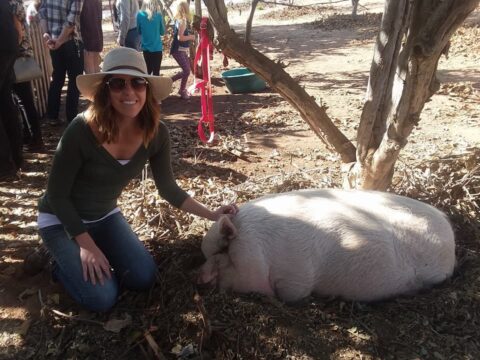Explainer
The Deep History of Racism and Speciesism Behind ‘They’re Eating the Dogs’
Election 2024•7 min read
Perspective
Learning about racial inequity through the lens of data analysis not only improves the efficacy of my animal advocacy, but it fuels my commitment to fighting all forms of oppression.


Words by Brooke Haggerty
The conference room was packed with passionate animal advocates humming with conversation. “Did you catch the film screening last night?” “What did you think of the keynote?” With a long weekend behind me and a vegan cupcake in hand, I found a seat for the concluding plenary. As the speakers took their places and the room quieted down, I took notice of my surroundings, nodding and smiling at my colleagues and peers—each of us there because of our fierce dedication to ending the suffering of animals. Leaders from prominent organizations across the country had come together, united in that shared commitment to animal protection. I was proud to be one of them.
But as my eyes swept across the conference room, the excitement and motivation from the last few days drained out of me. A commitment to the cause wasn’t the only thing that we all had in common. Staggeringly, and with few exceptions, I realized that most people in the room were white.
Eventually, someone pointed this out. But no one knew what to do about it.
I kept hearing this phrase as I began educating myself about the importance of diversity, equity, and inclusion (DEI) in the workplace. Unsure of what it meant or how to contribute to the change I wanted to see, I turned to my usual source of clarity in times of uncertainty: research and data.
As a bookworm who studied human behavior, I’ve always had an inclination toward the analytical. My inherent curiosity (always asking “why?”) has guided me toward using research as a basis for understanding. This is what led me to join Faunalytics, a nonprofit that provides research to support effective animal advocacy. When my advocacy is data-driven, I feel confident knowing that I’m using my time and resources effectively.
Deep-diving into a career around research taught me many things about animal advocacy, and I was immediately transfixed by what I was learning. Research tells us that animal advocates are very similar demographically. The North American mainstream movement and its sympathizers are disproportionately female, white, and middle-class. As one example, in a survey of 13 animal welfare organizations with a combined total of 1,584 employees, 62 percent had no Black employees. Not only is animal protection made up of a white majority, but we in turn project this image back to the public through advocacy materials and media.
As I evolved in my animal advocacy, these facts kept rattling around in my head. The question lingered: What should we do with this information?
Perhaps this is where you are in your journey: you know the animal rights sector is dominated by white advocates, and you know that our efforts to create a more inclusive environment haven’t been enough. Perhaps, like me, you’ve found this similar to the experience of discovering the atrocities of factory farming—once you know, it’s hard to go back.
So you keep learning, determined to make it better.
After diving into as much research as I could find on inequity in our movement, I reflected on my own experiences in animal advocacy. Conferences packed with predominantly white advocates were only the tip of the iceberg, and I realized just how much was a stake because of this.
I certainly had my work cut out for me. How could advocates reach our goal of ending animal suffering when only one point of view—that of white folks—dominated our efforts toward this goal? Unsure of what I needed to learn (and unlearn), I went back to the drawing board for some core definitions.
Prejudice is the pre-judgment about another person based on the group(s) to which that person belongs, typically negative and based on unsupported generalizations. Action that is based on prejudice is discrimination. And racial prejudice + power = racism, the structure in which collective prejudice toward a group of people based on race or ethnicity is backed by the power of legal and institutional authority that sustains systems of oppression. (This is why “reverse racism” is a myth—marginalized groups do not wield institutional power that upholds systematic racism.)
As Dr. Robin DiAngelo writes in White Fragility: Why It’s So Hard For White People To Talk About Racism, racism is often reduced to “simple, isolated, and extreme acts of prejudice.” When prejudice and discrimination are confused with racism, a fervent good/bad binary is established (racist vs. not racist), making it “effectively impossible for the average white person to understand—much less interrupt—racism.” This is one reason why it’s so difficult to fully understand the extent to which we live and operate in a white supremacy culture.
White supremacy culture? “Wait a second,” you’re thinking. “I don’t think I’m racist, but I know I’m not a white supremacist!”
This was a tough one for me, too. Let’s set aside Klan images and think of white supremacy culture as an unnamed system in which cultural norms and structures (held in place by systems of power) encourage and reinforce white privilege. In other words, whites control the dominant narratives (wealth, government, military, education, media, entertainment, etc.) in our society.
Sadly, this is also true within the North American and European animal protection movements. “Some of the most popular theorists, filmmakers, writers, and thinkers in the mainstream animal rights movement are white people,” Aph Ko—a decolonial theorist who founded Black Vegans Rock, co-authored Aphro-ism: Essays on Pop Culture, Feminism, and Black Veganism from Two Sisters, and authored Racism as Zoological Witchcraft—recently explained. “White people run some of the largest and most influential animal rights and vegan organizations. They also get the most funding in this movement.”
Unsurprisingly, this is the case for the nonprofit sector as a whole. One study found that revenues of Black-led organizations are 24 percent smaller than the revenues of their white-led counterparts. As a white executive and fundraiser, I read this and felt a pit in my stomach as my privilege stared back at me, a partner in my success.
Knowing that white supremacy culture exists in our society and in our sector—and that the mainstream movement’s association with whiteness is a major deterrent to Black and Indigenous people of color—white animal advocates have an obligation to make the animal protection community an equitable space. This is our obligation not because the data tell us that doing so will increase our impact, but because our commitment to fighting oppression should not be limited to nonhuman animals. And as someone who wields power, this is my responsibility too.
So what does it mean to create an equitable space? Equity is the concept of treating everyone fairly by acknowledging and addressing everyone’s unique situation and systemic barriers. This is very different from equality, where everyone is treated the same and has access to the same opportunities. For example, if everyone has access to a bicycle for transportation, that is equal. However, this does not consider the needs of those who cannot ride a bicycle and is therefore not equitable. Racial inequity exists in our movement both internally (within organizations) and externally (via public-facing advocacy).
Wading through definitions and data kindled my commitment to keep learning. As I continued my research, three clear examples of racial inequity in animal advocacy emerged:
This is all quite a bit to take in for any white animal advocate. Most of us became involved in this line of work because we’re committed to ending the suffering of billions of animals. Finding out that we might be addressing one oppression while ignoring another is hard to reckon with. This is what makes me even more determined to extend my worldview and broaden my activism. Without racial equity, animal rights cannot effectively move forward.
Research indicates that the lack of diversity in our movement may be hindering our ability to make a difference for animals. In the essay “How Diversity Makes Us Smarter,” Dr. Katherine Phillips examined years of research and found that diversity enhances creativity. “It encourages the search for novel information and perspectives, leading to better decision-making and problem-solving.” Diverse groups engage in more careful information processing and McKinsey & Company’s findings indicate that diverse companies are better positioned to improve their client relations and employee satisfaction.
One study of animal activist burnout identified racism as a key contributor to burnout, as activists of color reported being unsatisfied with the diversity of our movement and the apparent disinterest in remedying this among white activists.
Faunalytics published a new study last week that examined why some animal advocates leave the movement while others stay engaged long-term. Factors included burnout, traumatic stress, discrimination and harassment, pay and benefits, and lack of opportunities for training and advancement. We found that many of these experiences were affected, usually negatively, by being a member of a minoritized group.
If we want to achieve a greater impact for animals by exploring and supporting the new ideas, relationships, and resources that come with an equitable and inclusive movement, we have to “do the work.” Here are a few ideas to get white animal advocates started:
Dismantling inequity in our movement is both an individual and collective process that will require ongoing conversations and commitment to change. The conference I attended that opened my eyes to these issues was years ago now. Since that pivotal moment, I have found myself digging deeper and deeper into my own role in creating a more equitable animal rights movement.
I have fallen short in the past. I have said the wrong things, or have said the right things the wrong way, or I’ve said nothing when almost anything would have been better than staying silent. I’ve made mostly white hires, and I’ve voted in favor of motions that my colleagues of color never got behind. I’ve donated to organizations without questioning whether they were engaging in equitable practices. I’ve benefited from the color of my skin, time and time and time again, ignorant of the role my privilege played.
How can I do better? How do we move from white guilt to accountability? I’ve found that this work is an ongoing process, something we must practice continuously. With every decision I make, I have the chance to learn and improve, to listen and change. Every day is a new opportunity to strengthen my advocacy and my humanity.
I know that I’m not alone. As advocates who oppose the exploitation of billions of nonhuman animals, we are actively confronting systems of oppression that cause so much suffering. More and more, I see my fellow white advocates speaking up at conferences, attending trainings, and holding one another accountable. I see priorities reshaping and policies changing. I see the passion in the movement, the fire in our eyes that ignites when we bear witness to injustice.
I know that fire is in your eyes—it’s in mine, too. Let’s do the work together, and fuel it.